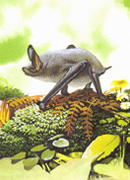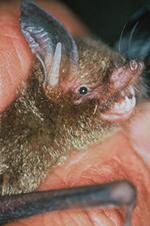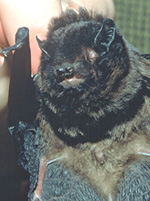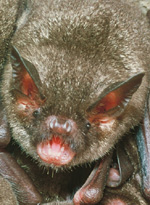|
NEW ZEALAND ECOLOGY |
| |
|
|
MAMMALS |
| |
|
New Zealand's only native land mammals were three species of bat. Two species of short-tailed bats, were the world's most terrestrial bats, and the result of the bat family's attempt to produce a mouse. The lesser short-tailed bat Mystacina tuberculata is now the sole surviving member of the family Mystacinidae which is endemic to New Zealand. The family is one of four in the superfamily Noctilionoidea which, with the exception of Mystacina is restricted to central and south America. Mystacina is a sister taxa of the genus Icarops consisting of three early Miocene species in Northern Australia. Mystacina probably dispersed to New Zealand with prevailing winds from Australia in the late Oligocene or early Miocene about 30 million years ago. |
|
|
|
Since the time of Maori settlement in the 13th century until its last sighting in 1967, one of
the two surviving members of the ancient Mystacinidae family, the greater short-tailed bat was
known only from Big South Cape Island, and adjoining Solomons Island off Stewart Island.
It became extinct after rats got ashore from a fishing vessel. Only fossils have been
found at various locations in the North and South Islands where it was once widespread.
 See more See more |
 |
|
Three very odd subspecies, the world's sole survivors of the Mystacinidae family, remain
at 13 locations throughout New Zealand. They feed on the ground hopping and darting through
the forest, with wings folded in a pouch, using their arms as front limbs. They are
relatively poor fliers, normally flying two or three metres off the ground.
 See more See more |
 |
|
The long-tailed bat arrived more recently than the Mystacina bats,
assumably by windblown flight from Australia across the Tasman Sea. It is a close relative of
five wattled bat species widely distributed throughout the western Pacific. It is New
Zealand's smallest bat, is more common, and is very different than the unique short-tailed
species. It is a better flier with a large homing range, and is an aerial insectivore,
still widespread throughout the country.
 See more See more |
 |
Photo Credit Top right: Short-tailed bat cluster, Ohakune, B.D. Lloyd
Center middle: Short-tailed bat, Codfish Island, B.D. Lloyd
Center bottom: Long-tailed bat, Gisborne, Dick Veitch
Crown Copyright © Department of Conservation.
Illustration Credit Center top: Greater short-tailed bat, Peter Schouten
|
| |
 |

|
|

| |
| |
2005 New Zealand Threat Classification System
Greater short-tailed bat
Mystacina robustus
[8] Data deficient
Northern short-tailed bat
Mystacina tuberculata aupourica
[2] Nationally endangered
Eastern central short-tailed bat
Mystacina tuberculata rhyacobia (eastern)
[7] Range restricted
Northwestern central short-tailed bat
Mystacina tuberculata rhyacobia (north-western)
[7] Range restricted
Southern North Island southern short-tailed bat
Mystacina tuberculata tuberculata (southern North Island)
[1] Nationally critical
South Island southern short-tailed bat
Mystacina tuberculata tuberculata (South Island)
[2] Nationally endangered
Long-tailed bat (North Island)
Chalinolobus tuberculatus (North Island)
[3] Nationally vulnerable
Long-tailed bat (South Island)
Chalinolobus tuberculatus (South Island)
[2] Nationally endangered |
| |
2007 IUCN Red List of
Threatened Species
New Zealand greater
short-tailed bat
Mystacina robustus
Extinct
New Zealand lesser
short-tailed bat
Mystacina tuberculata
Vulnerable
New Zealand long-tailed bat
Chalinolobus tuberculatus
Vulnerable
|
| |
|


